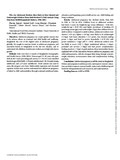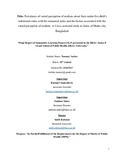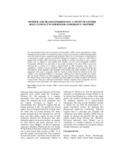Why are adolescent mothers more likely to have stunted and underweight children than adult mothers? A path analysis using data from 30,000 Bangladeshi mothers, 1996–2014

View/Open
Date
2020-05-29Publisher
Oxford AcademicAuthor
Nguyen, PhuongScott, Samuel
Khuong, Long
Pramanik, Priyanjana
Ahmed, Akhter
Afsana, Kaosar
Menon, Purnima
Metadata
Show full item recordCitation
Nguyen, P., Scott, S., Khuong, L., Pramanik, P., Ahmed, A., Afsana, K., & Menon, P. (2020). Why are adolescent mothers more likely to have stunted and underweight children than adult mothers? A path analysis using data from 30,000 Bangladeshi mothers, 1996–2014. Oxford Academic, 4(Supplement_2), 1463. doi:https://doi.org/10.1093/cdn/nzaa061_091Abstract
Objectives:
Adolescent pregnancy is a major global concern due to its adverse effects on maternal and child health and wellbeing. Bangladesh has one of the highest rates of adolescent pregnancy globally. We sought to examine trends in adolescent pregnancy and associated factors in Bangladesh in the last two decades, and to understand why children of adolescent mothers are at high risk of poor growth.
Methods
Data were from 6 rounds of Bangladesh Demographic and Health Survey (1996–2014). Women aged 15–49 years who gave birth in the 5 years preceding each survey (n = 30,331) were classified based on age at first birth: ≤19 years (adolescence), 20–24 years (young adulthood), and ≥25 years (adulthood). Trend analysis was used to assess the progress over time. Multivariable regression and structural equation models were used to understand how adolescent pregnancy is linked to child undernutrition through maternal nutritional status, education and bargaining power, health service use, child feeding and living conditions.
Results
Adolescent pregnancy has declined slowly, from 84% in 1996 to 73% in 2014. Children born to adolescent mothers had lower z-scores for height-for-age (mean difference: −0·64 SD), weight-for-age (−0·45 SD), and higher prevalence of stunting (18 percentage points [pp]) and underweight (12pp) than children born to adult mothers. Compared to adult mothers, adolescent mothers were shorter (−0·8 cm), lighter (−6.9 kg), more likely to be underweight (+14pp), had lower education (−4·3 years), less decision-making power (−9pp), and lived in poorer households (−0·79 SD) with poorer sanitation (−23pp) (all P < 0.05). Adolescent mothers were less likely to access ANC (−20pp), institutional delivery (−42pp), postnatal care services (−24pp) and had poorer complementary feeding practices (−15pp). In path analyses, these intermediate factors explained 66% of the association between adolescent pregnancy and child anthropometry, with the strongest links being through women's weight, education, socioeconomic status and complementary feeding practices.
Conclusions
Adolescent pregnancy is still the norm in Bangladesh. Policies and programs to address poverty and improve women's education can help to improve women's health, reduce early childbearing and break the intergenerational cycle of poverty and undernutrition.
Description
This article was published in Current Developments in Nutrition by Oxford Academic [ © Oxford University Press 2020.] and the definite version is available at: https://doi.org/10.1093/cdn/nzaa061_091 The Journal's website is at: https://academic.oup.com/cdn/article/4/Supplement_2/1463/5845785Department
Brac James P. Grant School of Public HealthType
Journal ArticleCollections
Related items
Showing items related by title, author, creator and subject.
-
Assessment of knowledge of community health workers and mothers on infant and young child feeding and practices of mothers
Chowdhury, Anita Sharif; Islam, Qazi Shafayetul; Roy, Sanjit (BRAC Research and Evaluation Division (RED), 2013-10)Poor infant feeding practices are some of major causes of under-nutrition in children under five years of age in Bangladesh. In order to address the issue, BRAC ·has implemented the Alive and Thrive (A&T) programme to ... -
Prevalence of varied perception of mothers about their under-five child’s nutritional status with the measured status and the factors associated with the varied perception of mothers. a cross-sectional study in slums of Dhaka city, Bangladesh
Sarker, Tanmoy (Brac University, 2023)Abstract Objective: Childhood malnutrition is a serious public health concern as it hampers a child’s physical and cognitive development. Maternal misperception about their child’s nutritional status can increase the ... -
Mother and transgendered son: a study of gender role conflict in Sherwood Anderson’s “mother”
Hossain, Sanjeeda (© 2016 Published by BRAC University, 2016-10)In a conventional society men are expected to be masculine. Unlike women, they must be resolute, authoritarian and truculent. In comparison to men, women are presumed to exhibit feminine gender traits like submissiveness, ...



